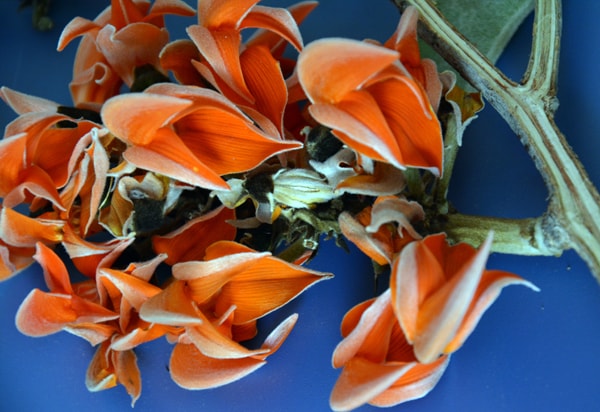
*Prabhat Kumar's Picture shows Palash Tree and its blooming flowers in Hazaribagh,
Monsoon has started to green the land.A few months back,heat of summer had left the land yellow.This was the time when I was in forest of Hazaribagh where I met a group of Adivasis.All of them were walking barefoot.
I saw them sweating.The sky looked dazzling.Suddenly,all Adivasis-six of them-all male-stopped and sat under the shade of a school building.I joined them.Soon,we became friends and started talking and discussing.
One of them talked about the heat of summer.The other guy appeared tense due to water scarcity in his village.Yet another one looked at me and asked if I am thirsty.Minutes later,before they moved and vanished from the scene,I raised a question linked with tradition,time and colour of trees and flowers around.The question was –why every month is not known by colors of flowers it helps bloom on plants and trees?
All of them kept mum.I looked at some nearby trees and flowers whose spectacles were visible during the hot summer-March-April.Though leaves were green,flowers were yellow,brown and red.”All these are God’s creation”,said one Adivasi.
My mind travelled deep in the sky.Since this month is known by the name of Mars,the Red Planet,another question gripped my mind-Is there any link between the colour of flowers and Mars?
No body knows the truth.However,one Adivasi answered in affirmative.”Nature rules”,he opined.I told him that there can be a connectivity between the Red planet and flowers.Otherwise,I told them,why all flowers in March bloom in scarlet,orange and red colour.Does Mars cast an enchanting red spell on these flowers?
No scientist is learnt to have provided any answer.Yet,the truth is Semal, Palas, Scarlet Bell tree and Bottle Brush tree blossom almost simultaneously during March-April,displaying red as their base colour.I think ‘Red’ has been interpreted in psychology as a ‘violent’ colour, a colour of passion and power, of love and devotion, danger, death and destruction - of earthly sensuous beauty – admired and detested in equal but opposite force.
Every body knows that March is the month in transition from winter to summer - harbinger of hot season - aptly described by Charles Dickens in Great Expectations- “It was one of those March days when the Sun shines hot and the wind blows cold: when it is summer in the light and winter in the shade.” This describes spring time in Jharkhand and across India.
In the bouquet presented this month by Mother Nature, consisting of flowers mentioned above, Palash flowers find a pride of position, in poems of Kalidas, Jaydeva, Ravindranath Thakur and also in folk lores of Adivasis,in unsurpassed fervor and unfathomed emotional content. A newly wedded bride in red garments, a blazing fire waving in the wind, flower resembling bright red beak of parrot, are some of the highly colorful description attributed to Palash flowers.
Such wonderful descriptions add charm and colour to our lives!
A loving close look at a Palash flower,sparkles its supernatural beauty.Its all pervasive magnetism radiates in the air.Though I was surrounded by these Adivasis,a fully blossomed Palash tree had left displaying rough, dark-grey bark of trunk with devilish looking, crooked and twisted branches – ungainly enough to repel the viewer away from the site.
A month before March,February had arrived and disappeared.During this time,branches were fully covered with deep dark, chocolate brown buds.Next,within a spell of seven days – from the first week of March – the tree was on fire, ablaze with flames of orange-scarlet blooms, as if touched by the magic wand of a charmer!
Was it the effect of planet Mars, lending its fiery red colours to Palash?Designer is God.I can only say that Palash flowers are short- lived, hardly lasting for a fortnight. This divine beauty blazes in a flash as all beauty is ephemeral.
Any byte?None of the Adivasis replied in the negative.”It is the red flower of Nature-March is just an imaginative concept of mankind.”
Geologically,Palash is a native of tropical Indian sub-continent and bears numerous names in Hindi and other vernacular languages from mythological days,each signifying its socio-religious- cultural influence on masses. In Sanskrit, it is Kimshuk- Is it parrot?
In Hindi, it is known as Dhak, Palash and Tesu – nomenclature used profusely in proverb, poems and songs; in Kannada and Malayalam, Brahm Briksha/ Brahm Briksham – reverential and the most appropriate of them all to describe it. Common names in English also abound such as Flame of the Forest, Bastard Teak, Parrot Tree and so on.
Scientifically it is called Butea frondosa and Butea monosperma. Frondosa signifying leafy, full of leaves and monosperma means one seeded- bearing a single seed in a fruit. ‘Butea’ was coined in honour of John Stuart, the third Earl of Bute, who demonstrated extra ordinary interest in botanical pursuit. The names, common or scientific, sound highly romantic. Few trees command so many names with so varied meanings.
I any case, In the world famous spring festival at Shantiniketan, initiated by Nobel Laureate Rabindranath Tagore, Palash flowers form an indispensable part in this celebration. The poet had sung in these words:
"A little touch? Feel, a few words? Hear with what? Write my spring- song in my mind. Some ecstasy of Palash."
